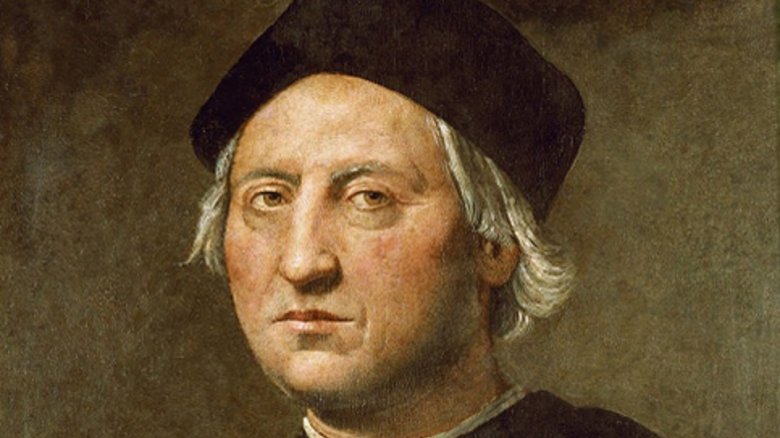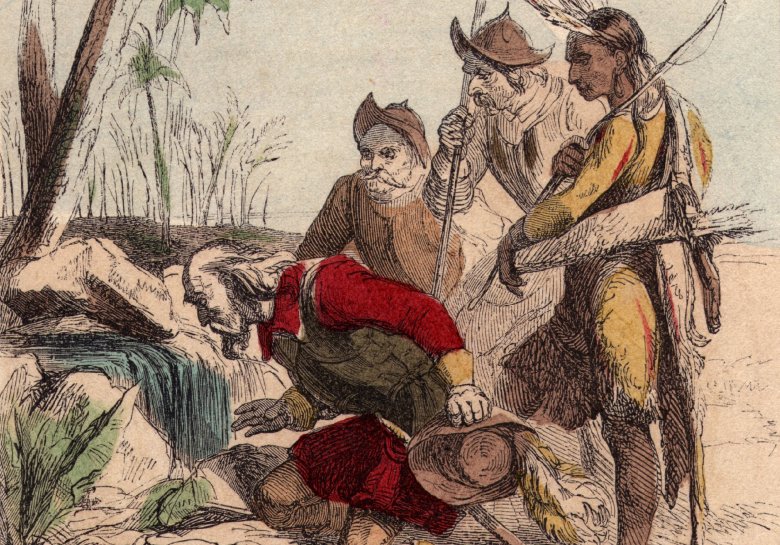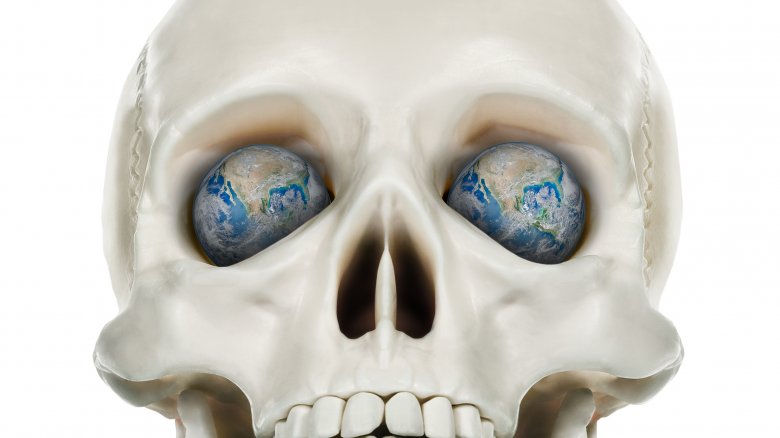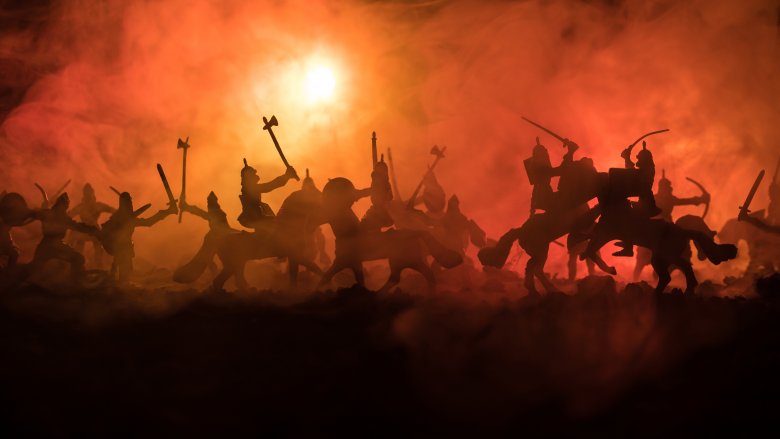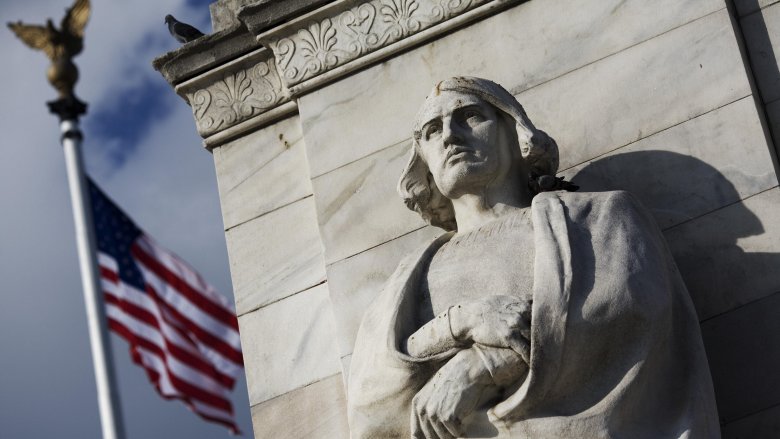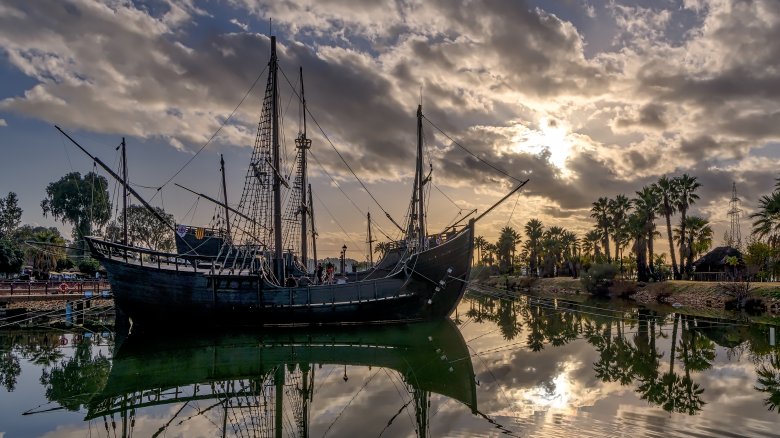Weird Things About Christopher Columbus You Didn't Know
It might seem difficult to discuss Christopher Columbus in a neutral way nowadays, especially in the U.S., where he basically used to be considered a Founding Grandfather. And it would definitely be difficult to discuss weird things about him without first acknowledging the historical elephant in the room, mostly because Columbus enslaved that elephant after claiming the room in the name of Spain. Plus, he didn't land where he planned, he despoiled the soil he landed on, and he soiled his accomplishments with acts of unconscionable cruelty.
However, it's also worthwhile to explore things you may not know about Christopher Columbus, the not-so-admirable admiral who sailed the ocean blue in 1492, 1493, 1498, and 1502. Surprisingly, not all of those things will make you wish the International Criminal Court existed during the 1400s. Some are absolutely absurd, and others border on being bewildering. But all will be wilder than a trip to the zoo.
He believed Eden was Earth's nipple
Humans have long likened the world to a woman. Nobody's heard of Papa Planet, but everyone knows Mother Earth. Countless men have cried "But you're my whole world!" to keep a women from leaving them. And who hasn't pictured Earth as a lady's jiggly milk jug? Whoa, what? Well, at least one person has: Columbus.
Actually, it's unclear if Columbus thought Earth jiggled. But he believed it had a round base and an upright bulge shaped "like a woman's breast," according to the Florida Museum. He also asserted that at the peak of Planet Mammary sat the Garden of Eden -– or as the New Yorker's Elizabeth Kolbert called it, "the nipple of the world." Clearly, this raises some questions, such as, "would that make grass the world's chest hair?" and "are clouds Earth's cotton bra?" But the most pressing question is unquestionably "why?"
Columbus arrived at his idea in 1498 after reaching the coast of Venezuela during his third voyage. However, he thought he had reached Asia and noticed discrepancies between his observations and expectations. The weather and water seemed wrong, the North Star looked misaligned, and he felt like he was sailing skyward. Rather than assuming he made a mistake, he reasoned that the ancient Greeks goofed when they determined the world was spherical. Why did he specifically reference lady lumps in his assessment? Maybe he was thinking with his man mast.
He incited a fight with dancing
Communication is complicated, especially when the communicators don't speak the same language. Even with the aid of Google Translate you can erroneously order 15,000 eggs from a grocery store when you wanted 1,500. The 15th-century version of Google Translate was essentially guessing, which is how Columbus ended up with egg on his face.
Per National Geographic, Columbus had plotted a course (for a place he didn't find) and ended up in Trinidad. As his ship approached the shore, the explorer spotted people in ornate headscarves near canoes. Drawing from the writings of Marco Polo, Columbus figured he may have found natives of India who had gold, spices, and people he could enslave. Hoping they would want to trade, he tried to wave them over. You might recognize this as the aquatic equivalent of a dude in an unmarked white van asking you to approach his vehicle. The Trinidadians also seemed to recognize this and stayed put.
Then Columbus tried to attract them with shiny objects like pans, which created interest but no actual interaction. Finally, he had a crewman perform a jig while playing a tambourine to entice "some young men to dance, believing that they would draw near." But rather than flocking to Columbus' floating van, the Trinidadians fired arrows. Perhaps the inhabitants took it as a war declaration, or maybe the jig was just really bad, but the two sides battled, parted ways, and never interacted again.
He found mermaids unattractive
Christopher Columbus lived in an age when believing in mermaids made sense. Obviously, he didn't see any, but he thought he did during his first voyage. That sounds like a sight that should excite any seaman, but Columbus seemed to consider it a letdown. Referring to himself in the third-person, he wrote in 1493: "When the Admiral went to the Rio del Oro [Haiti], he said he quite distinctly saw three mermaids, which rose well out of the sea; but they are not so beautiful as they are said to be, for their faces had some masculine traits." Now you can add superficiality to Columbus' long list of shortcomings.
Apparently, Ariel was a butterface. But her face probably belonged to a manatee, according to National Geographic. Also called sea cows, manatees and similar animals such as dugongs inadvertently fooled sailors into thinking that human-fish hybrids exist for hundreds of years. They've been known to perform "tail stands" and have flipper-like forelimbs with finger-like bones. They were so good at tricking seamen that they're now scientifically classified as Sirenia, an allusion to the seductively lethal fish-women of Greek mythology known as sirens. Though Columbus didn't seem wowed by the man-faced "mermaids" he saw, European sideshows capitalized on his claim by showcasing the skeletons of manatee-like animals as newly discovered mermaids.
He partly started the zombie apocalypse
Mermaids weren't the ugliest thing about Columbus' first trip to the New World. As Atlas Obscura observed, his hideous behavior laid the groundwork for modern zombie lore. It started when Columbus called dibs on the Caribbean island of Hispaniola (present-day Haiti and the Dominican Republic). As Yale University detailed, in 1492, Hispaniola was inhabited by between a few hundred thousand and more than a half-million Taino people. In 1493 Columbus turned it into Spain's first permanent settlement in the New World. Soon settlers inundated the island, depleted its resources, and enslaved the Taino. By 1514, only an estimated 20,000 to 32,000 Taino remained.
The decimation of the indigenous population prompted future colonizers to drag African slaves to Hispaniola. Sugar cane plantations cropped up, and slaves' lives were cut short. Mortality rates reached thrice that of other kinds of plantations due to grueling, gruesome conditions. Slaves began longing for the afterlife, and many resorted to suicide in hopes of liberating their souls. To cope, they developed Hatian Vodou, a voodoo-like religion that stresses creating concord with the dead.
Vodou priests purportedly possessed the power to shepherd souls into the afterlife or trap them on Earth to work as undead slaves, or zombies. These ideas later gave rise to 1968's Night of the Living Dead, the movie that immortalized zombies. Per The Atlantic, director George Romero envisioned the living dead as "undead Haitian slaves."
His son's dispute with Ponce de León spawned the Fountain of Youth legend
Most of the men who accompanied Christopher Columbus were swept under history's rug. But one rugged crewmate became a mythical figure. Juan Ponce de León joined Columbus on his second expedition in 1493 and later established Florida as a Spanish colony. Legend has it that he accidentally found Florida in 1513 while seeking the Fountain of Youth. In truth, that story started off as an enemy's attempt to portray Ponce as an impotent idiot searching for magical Cialis water.
It all began when Columbus' son Diego kicked Ponce out of San Juan Bautista (present-day Puerto Rico) in 1509. As Smithsonian Magazine explained, Diego was royally ticked at King Ferdinand for failing to honor promises made to Columbus, who died in 1506. He also wanted to curtail Ponce's political power. A former Spanish warrior, Ponce ascended the ranks of the Spanish fleet after sailing with Columbus. According to History, in 1504, Ponce helped quell a Taino uprising in Hispaniola –- an island Diego's daddy conquered –- and in 1508 Ferdinand permitted Ponce to colonize San Juan Bautista.
Ferdinand let Diego oust Ponce but gave the latter another chance to govern in 1512. The island of Bimini was Ponce's to rule if he could find it. Instead he stumbled across Florida. In 1535 one of Diego's allies depicted Ponce's failed quest to claim Bimini as a harebrained hunt for a fountain that could revitalize his manhood.
His bones bounced between countries
Columbus didn't get to see Ponce de León star in a mock male enhancement ad because his body was busy being colonized by worms. As History described, his final years had been a parade of disappointments. In 1502 he ventured westward a fourth time. His goal: to find gold and the Garden of Eden. Four years prior he had theorized that Eden was the terrestrial cherry atop a mammary sundae, and now he was milking that idea. Instead of finding paradise, Columbus found himself stranded in Jamaica for a year.
In 1504 his biggest backer, Queen Isabella, died. Columbus' health declined, and King Ferdinand declined his requests for compensation. In 1506 Columbus died. Then his body embarked on a batch of new journeys. Per ThoughtCo, Columbus wanted to decay in the New World, but because it wasn't fancy enough, he was buried in Valladolid, Spain. Then he was interred near Seville before being relocated to Santo Domingo, Hispaniola (which became the Dominican Republic's capital), to be buried with his son Diego. When Spain relinquished Hispaniola to France in 1795, Columbus got shipped to Cuba.
During the Spanish-American War, Columbus' remains returned to Spain. Or did they? In 1877 Dominican workers unearthed the supposedly still-buried bones of Columbus in Santo Domingo's cathedral, leading the Dominicans to speculate that Spain received the wrong bones. Currently, the Dominican Republic and Spain both claim to have Columbus' remains.
He dreamed of conquering Jerusalem
If Christopher Columbus had an afterlife, he probably spent it attempting to discover heaven while unwittingly sailing to hell. But had he achieved his pre-death dream, heaven would have come to him. In addition to wanting to give Earth a purple nurple, Columbus aspired to bring about biblical oblivion.
History professor Paul Boyer informed "Frontline" that Columbus "took apocalyptic teachings" and "biblical passages very, very literally." So while Columbus never believed he would sail off the end of world during his voyages, he did think they would cause the end of the world. Toward the end of his life he even created a compendium of apocalyptic texts titled The Book of Prophecies, whereby he applied end-of-days predictions to himself. In his interpretation, Ferdinand and Isabella ruled the world's final empire, and he was the key to Christian victory over Islam, which could only be accomplished by conquering Jerusalem.
For context, Jerusalem had passed between Christian and Muslim hands during the Crusades before the Muslims once again gained control in 1187. Columbus claimed that reclaiming the holy city would trigger a "messianic period." Starting that period would involve lots of bloodshed, which meant Columbus needed lots of gold to fund a military campaign. He even pitched the idea to Ferdinand and Isabella using the The Book of Prophecies. Unfortunately for him, those predictions didn't include the part where he died before fulfilling them.
He became a symbolic middle finger to Great Britain
U.S. citizens have sung Columbus' praises since the late 18th century, with the first Columbus Day celebration occurring in 1792 courtesy of Tammany Hall. Before the Revolutionary War, however, Americans considered him more of a historical footnote or one of time's toenail clippings. When the colonials got ready to rumble with redcoats, they suddenly began treating Columbus like the lovechild of the Liberty Bell and a bald eagle.
Historian Evan Jones told Smithsonian Magazine that Americans craved a symbol of independence that bore no connection to Britain. To the colonists, Columbus "had turned his back on the Old World" on behalf of Spain, only to be incarcerated by Spain's king later. Ironically, Columbus was apprehended for torturing the tarnation out of Hispaniola's populace, per the Guardian. Among other sadistic misdeeds, he had denizen's noses and ears lopped off for minor crimes before selling those mutilated people into slavery. This arguably made Columbus much more tyrannical than King George III, who didn't mix taxes with torture.
Americans spun an inspiring narrative around Columbus. As The Nation noted, one source of inspiration was a 1777 book that portrayed Columbus as a well-meaning maverick who tamed feral Native Americans. Although he never visited continental North America and didn't know it existed, Columbus was credited with "discovering" it. Americans nearly named the nation "Columbia" but instead called the nation's capital the District of Columbia.
No one really knows what he looked like or where he came from
Christopher Columbus' existence was defined by ignorance. He never knew he explored the New World. Early Americans didn't know he didn't know. At least one country doesn't know where his bones are. And apparently nobody knows Columbus' actual appearance or birthplace. Clearly, portraits of him exist, but as Scientific American noted, it's not clear that any were painted during his lifetime. Most existing images differ from written descriptions. Even a portrait purportedly authenticated by the Scientific American would misrepresent his age if it were otherwise accurate. The Metropolitan Museum touts a drastically different picture as the real deal but acknowledges that "other, quite different, portraits" also claim authenticity.
Columbus' background is similarly murky. The accepted narrative holds that he was born in Genoa, Italy. Somebody named Cristoforo Colombo definitely lived there, but as the New York Times pointed out, nothing conclusively identifies him as the explorer. Moreover, according to the Telegraph, Columbus may have simply assumed that name to conceal his true origins.
Some experts maintain that Columbus hailed from Spain. Linguistics professor Estelle Irizarry told CNN that Columbus wrote in the Spanish equivalent of Yiddish, suggesting he was a Spanish Jew who forsook his faith to escape the Inquisition. Moreover, he sometimes used Hebrew letters and had a hankering for conquering Jerusalem. Competing theories about his birthplace are all over the place, with one historian even asserting that Columbus was secretly Polish royalty.
His stolen letters also went on voyages
Regardless of his beginnings, Christopher Columbus ended up an international man of mystery. Appropriately, centuries after his death, Columbus would feature in a series of international mysteries. As Smithsonian Magazine recapped, on three separate occasions, letters the explorer wrote to Ferdinand and Isabella have gone missing and been replaced with impressive fakes. And much like the Niña, Pinta, and Santa Maria, all three documents journeyed to the New World.
One letter vanished from the Vatican sometime between 1921 and before 2004, when Georgia resident David Parsons procured it for $875,000 from a New York dealer. Parsons apparently thought the sale was above-board, so it must have sucked like the dickens to discover he blew such a ridiculous amount on stolen stationery. The letter was returned to the Vatican in 2018. That same year, a different original copy of the letter made its way back to the National Library of Catalonia in Barcelona after being uncovered by U.S. law enforcement. The BBC reported that that letter was sold twice, the second time for $1.1 million.
Two years prior, a similar incident had almost the same ending. Per NPR, sometime before 1992, someone filched a letter from Riccardiana Library in Florence, Italy. Again it wound up in New York, where it was auctioned off for $300,000 and ultimately donated to the Library of Congress. Authorities don't seem to have a clue who committed the heists or how.
